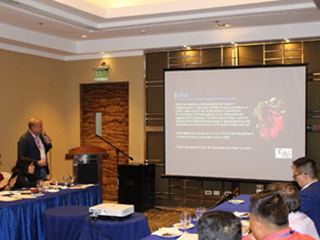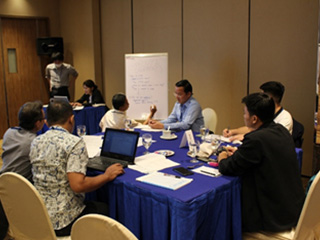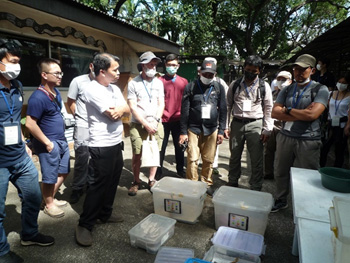What is CITES?
- Important Resolutions of CITES
- Recognition of the Benefits of Trade in Wildlife (Conf. 8.3)
- Criteria for amendment of Appendices Ⅰ and Ⅱ (Conf. 9.24)
- Sustainable Use of Biodiversity: Addis Ababa Principles and Guidelines (Conf. 13.2)
- CITES and Livelihoods (Conf. 16.6)
- Non-detriment Findings (Conf. 16.7)
- Japan's efforts to achieve the objectives of the convention (ESABII)
Discussions at the Conference of the Parties and Japan's Efforts
Important Resolutions of CITES
At the Conference of the Parties to the Convention on International Trade in Endangered Species of Wild Fauna and Flora (CITES), which has been held every two to three years since its inception in 1976, the Parties discuss various issues related to the implementation of CITES, and the results are adopted as resolutions or decisions.
Resolutions are usually intended to provide long-term guidance, and may include guidance on interpreting convention provisions, the establishment of various committees including Standing Committees, secretariat budgets, rules for controlling trade, and documents setting up a long-term convention compliance process. Decisions usually set out the work to be done by the Secretariat, various committees, and the Parties before the next meeting of the Conference of the Parties.
Here are some of the resolutions that have been adopted and are still in effect, which are important for understanding the concept and role of CITES. The resolution number indicates at which Conference of the Parties the resolution adopted and its order among the resolutions adopted at the respective Conference of the Parties.
Recognition of the Benefits of Trade in Wildlife (Conf. 8.3)
Although CITES Appendix-listed species have economic and commercial value, some of them, such as elephants and crocodiles, can be harmful to human livelihoods and difficult to coexist with. Even if a species is free of such conflicts, countries and regions with insufficient financial resources will be less inclined to actively conserve the species and its habitat if no legitimate economic or commercial value is attached to it by prohibiting its use.
This resolution was proposed by the southern African countries and adopted at the 8th Conference of the Parties (1992), which felt threatened by the growing belief that the commercial trade of wild fauna and flora had only a negative impact on the conservation of species, as seen in the debate over the listing of the African elephant as a whole in Annex Ⅰ (i.e., prohibition of commercial trade) at the 7th Conference of the Parties (1989).
This resolution includes a very important idea about the role of CITES, which states that commercial trade in species of wild fauna and flora can contribute to the conservation of species by making it easier to gain support for the conservation of species and their habitats by using the economic benefits of trade to fund conservation activities and to improve the lives of the people who coexist with the species.
Criteria for amendment of Appendices Ⅰ and Ⅱ (Conf. 9.24)
The criteria for inclusion in the Appendices (commonly known as the Bern Criteria), adopted at the first meeting of the Conference of the Parties (1976), did not provide objective criteria for determining the threat of extinction, and there were problems such as arbitrary amendments to the Appendices and the fact that it was easy to tighten regulations but difficult to reverse them. Therefore, this resolution was adopted at the 9th Conference of the Parties (1994), based on the draft new criteria submitted by the southern African countries at the 8th Conference of the Parties (1992), after consideration by the Standing Committee and the Animals and Plants Committees. Subsequently, amendments were made, particularly considering the application for aquatic organisms. This resolution contains six Annexes: criteria for the inclusion of species in Appendix Ⅰ and Ⅱ (Annex 1 and 2), special cases (Annex 3), precautionary measures (Annex 4), definitions, explanations and guidelines (Annex 5), and a format for proposals to amend the Appendices (Annex 6). Regarding the precautionary measures in the operative part and in Annex 4, it states “When considering proposals to amend Appendix Ⅰ or Ⅱ, the Parties shall, by virtue of the precautionary approach and in case of uncertainty either as regards the status of a species or the impact of trade on the conservation of a species, act in the best interest of the conservation of the species concerned and adopt measures that are proportionate to the anticipated risks to the species.” It is not stated that restrictions on international trade should be tightened when there is uncertainty, and the idea is expressed that tighter restrictions (for example, banning commercial trade in principle by moving from Appendix Ⅱ to Ⅰ) may not be desirable for conservation.
Sustainable Use of Biodiversity: Addis Ababa Principles and Guidelines (Conf. 13.2)
The term "sustainable use," which is closely related to CITES, is defined in Article 2 of the Convention on Biological Diversity as “the use of components of biological diversity in a way and at a rate that does not lead to the long-term decline of biological diversity, thereby maintaining its potential to meet the needs and aspirations of present and future generations.”
As most of the Parties to CITES are also Parties to the Convention on Biological Diversity (CBD), this resolution urges the Parties, when adopting non-detriment-making processes and making CITES non-detriment findings, to make use of the Sustainable Use of Biodiversity: Addis Ababa Principles and Guidelines [PDF 147KB](*), which were adopted at the 7th Conference of the Parties to the Convention on Biological Diversity (2004).
*Fourteen principles and implementation guidelines to help ensure that the use of biodiversity by governments, resource managers, indigenous and local communities, and the private sector does not lead to long-term biodiversity loss. It summarizes the basic concept of sustainable use of biodiversity, which is the second objective of the Convention on Biological Diversity.
CITES and Livelihoods (Conf. 16.6)
The preamble of CITES states, “Recognizing that peoples and States are and should be the best protectors of their own wild fauna and flora.” However, an amendment to the Appendix for a species of wild fauna and flora may restrict the use of that species by the inhabitants of the country of origin and have a significant impact on their livelihoods.
At the 13th Conference of the Parties, when Conf. 8.3 “Recognition of the Benefits of Trade in Wildlife” was revised to clearly state "The Conference of the Parties … recognizes that the implementation of CITES-listing decisions should take into account potential impacts on the livelihoods of the poor." In response to this statement, the Working Group on CITES and Livelihoods established by the Standing Committee has made recommendations on this issue and those are described in this resolution. The recommendations include empowering local communities, enabling them to implement policies, actively involving local communities in addressing illegal wildlife trade, and potential problems associated with shifting production systems from within to outside the habitat of wild fauna and flora.
Non-detriment Findings (Conf. 16.7)
Article 3(2)(a) and Article 4(2)(a) of CITES state that, for species listed in Appendix Ⅰ and Ⅱ, a condition for the issuance of an export permit is that “a Scientific Authority of the State of export has advised that such export will not be detrimental to the survival of that species.” Article 4(3) also states that for species listed in Appendix Ⅱ, “A Scientific Authority in each Party shall monitor both the export permits granted by that State for specimens of species included in Appendix Ⅱ and the actual exports of such specimens. Whenever a Scientific Authority determines that the export of specimens of any such species should be limited in order to maintain that species throughout its range at a level consistent with its role in the ecosystems in which it occurs and well above the level at which that species might become eligible for inclusion in Appendix Ⅰ, the Scientific Authority shall advise the appropriate Management Authority of suitable measures to be taken to limit the grant of export permits for specimens of that species.”
In order to comply with these provisions, when exporting an Appendix-listed species, the Scientific Authority of the exporting country is required to make a certification, based on scientific evidence, that export will not be detrimental to the survival of the species. This resolution recommends the Scientific Authority to take into account concepts, non-binding principles and references when determining that export will not be detrimental to the survival of a species, and encourages Parties to take the necessary measures to make the determination that export will not be detrimental to its survival, and directs the Secretariat to collect and maintain relevant information on the CITES website.
In addition, as a resolution that is closely related to this resolution, Review of Significant Trade in Specimens of Appendix-Ⅱ Species Conf. 12.8 [PDF 370KB] (Rev. CoP 18) establishes procedures for clarifying and, where necessary, improving the status of Annex Ⅱ listed species that may not be in compliance with the provisions of Article 4 of CITES.
Japan's efforts to achieve the objectives of the convention (ESABII)
In 2009, East and Southeast Asia Biodiversity Information Initiative (ESABII; Secretariat: Biodiversity Center of Japan, Nature Conservation Bureau, Ministry of the Environment) was established with the aim of contributing to the conservation and sustainable use of biodiversity in East and Southeast Asia, strengthening the scientific basis for biodiversity, and achieving the Aichi Biodiversity Targets through the development of biodiversity information and the enhancement of taxonomic capacity.
Under ESABII, in order to develop human resources with the necessary taxonomic knowledge and skills for biodiversity conservation, training workshop has been conducted for young researchers and government officials involved in biodiversity conservation, training manuals and identification sheets for species frequently treated in trade in Southeast Asia have been developed, and the networking of human resources, organizations, and information has been promoted.
As a part of such activities, Ministry of the Environment of Japan has been hosting the Training of Trainers (ToT) on CITES Policies and Identification of Threatened Species since 2011 to train trainers who are knowledgeable of the current status of trade and identification methods of endangered species of wild fauna or flora listed in the CITES Appendices and contribute to building taxonomic capacity in their countries. In this training program, resource persons such as CITES Secretariat officials and government officials who are active in the field of illegal trade prevention are invited as lecturers, and through means such as lectures, group work, and field training, they provide the trainees with knowledge on the recent situation of CITES, the actual situation of illegal trade in each country, and how to deal with such trade.

Lectures

Group work

Field training
Click here for more information on Japan's efforts regarding elephants Japan's efforts to achieve the objectives of the convention (MIKE Project)

